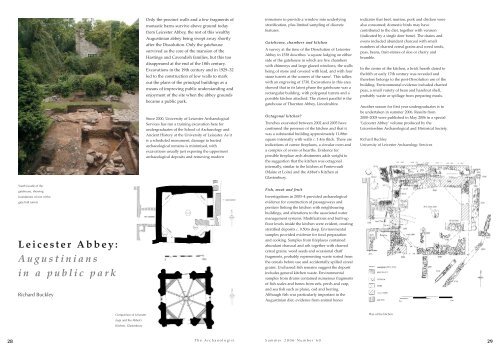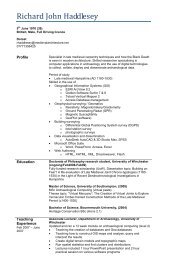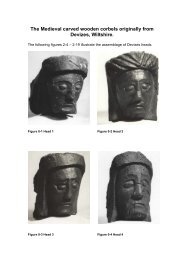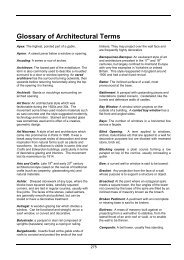The ARCHAEOLOGIST - English Late-Medieval timber-framed ...
The ARCHAEOLOGIST - English Late-Medieval timber-framed ...
The ARCHAEOLOGIST - English Late-Medieval timber-framed ...
You also want an ePaper? Increase the reach of your titles
YUMPU automatically turns print PDFs into web optimized ePapers that Google loves.
Only the precinct walls and a few fragments of<br />
monastic barns survive above ground today<br />
from Leicester Abbey, the rest of this wealthy<br />
Augustinian abbey being swept away shortly<br />
after the Dissolution. Only the gatehouse<br />
survived as the core of the mansion of the<br />
Hastings and Cavendish families, but this too<br />
disappeared at the end of the 18th century.<br />
Excavations in the 19th century and in 1929–32<br />
led to the construction of low walls to mark<br />
out the plans of the principal buildings as a<br />
means of improving public understanding and<br />
enjoyment of the site when the abbey grounds<br />
became a public park.<br />
Since 2000, University of Leicester Archaeological<br />
Services has run a training excavation here for<br />
undergraduates of the School of Archaeology and<br />
Ancient History at the University of Leicester. As it<br />
is a scheduled monument, damage to buried<br />
archaeological remains is minimised, with<br />
excavations usually just exposing the uppermost<br />
archaeological deposits and removing modern<br />
intrusions to provide a window into underlying<br />
stratification, plus limited sampling of discrete<br />
features.<br />
Gatehouse, chambers and kitchen<br />
A survey at the time of the Dissolution of Leicester<br />
Abbey in 1538 describes ‘a square lodging on either<br />
side of the gatehouse in which are five chambers<br />
with chimneys and large glazed windows, the walls<br />
being of stone and covered with lead, and with four<br />
stone turrets at the corners of the same’. This tallies<br />
with an engraving of 1730. Excavations in this area<br />
showed that in its latest phase the gatehouse was a<br />
rectangular building, with polygonal turrets and a<br />
possible kitchen attached. <strong>The</strong> closest parallel is the<br />
gatehouse of Thornton Abbey, Lincolnshire.<br />
Octagonal kitchen<br />
Trenches excavated between 2002 and 2005 have<br />
confirmed the presence of the kitchen and that it<br />
was a substantial building approximately 11.88m<br />
square internally with walls c. 1.4m thick. <strong>The</strong>re are<br />
indications of corner fireplaces, a circular oven and<br />
a complex of ovens or hearths. Evidence for<br />
possible fireplace arch abutments adds weight to<br />
the suggestion that the kitchen was octagonal<br />
internally, similar to the kitchen at Fontevrault<br />
(Maine et Loire) and the Abbot’s Kitchen at<br />
Glastonbury.<br />
indicates that beef, mutton, pork and chicken were<br />
also consumed; domestic birds may have<br />
contributed to the diet, together with venison<br />
(indicated by a single deer bone). <strong>The</strong> drains and<br />
ovens included abundant charcoal with small<br />
numbers of charred cereal grains and weed seeds,<br />
peas, beans, fruit-stones of sloe or cherry and<br />
bramble.<br />
In the centre of the kitchen, a brick hearth dated to<br />
the16th or early 17th century was revealed and<br />
therefore belongs to the post-Dissolution use of the<br />
building. Environmental evidence included charred<br />
peas, a small variety of bean and hazelnut shell,<br />
probably waste or spillage from preparing meals.<br />
Another season for first year undergraduates is to<br />
be undertaken in summer 2006. Results from<br />
2000–2005 were published in May 2006 in a special<br />
‘Leicester Abbey’ volume produced by the<br />
Leicestershire Archaeological and Historical Society.<br />
Richard Buckley<br />
University of Leicester Archaeology Services<br />
South facade of the<br />
gatehouse, showing<br />
foundations of one of the<br />
gate hall turrets<br />
Leicester Abbey:<br />
Augustinians<br />
in a public park<br />
Richard Buckley<br />
Fish, meat and fruit<br />
Investigations in 2003–4 provided archaeological<br />
evidence for construction of passageways and<br />
pentices linking the kitchen with neighbouring<br />
buildings, and alterations to the associated water<br />
management systems. Modifications and built-up<br />
floor levels inside the kitchen were evident, creating<br />
stratified deposits c. 0.50m deep. Environmental<br />
samples provided evidence for food preparation<br />
and cooking. Samples from fireplaces contained<br />
abundant charcoal and ash together with charred<br />
cereal grains, weed seeds and occasional chaff<br />
fragments, probably representing waste sorted from<br />
the cereals before use and accidentally spilled cereal<br />
grains. Uncharred fish remains suggest the deposit<br />
includes general kitchen waste. Environmental<br />
samples from drains contained numerous fragments<br />
of fish scales and bones from eels, perch and carp,<br />
and sea fish such as plaice, cod and herring.<br />
Although fish was particularly important in the<br />
Augustinian diet, evidence from animal bones<br />
Comparison of Leicester<br />
Plan of the kitchen<br />
(top) and the Abbot’s<br />
Kitchen, Glastonbury<br />
28<br />
<strong>The</strong> Archaeologist<br />
Summer 2006 Number 60<br />
29





